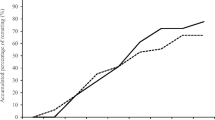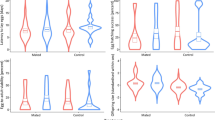Abstract
Multiple mating is common in insects and may bring direct and/or indirect benefits to females. Galerucella birmanica Jacoby feeds monophagously on water caltrop Trapa natans L. and is a serious pest in Asia where water caltrop is grown as an aquatic vegetable. It is also used as an effective biological control agent in North America, where water caltrop is a major invasive plant species. In this study, we tested the direct benefits of multiple mating when females were continuously exposed to males and had restricted exposure to males. Under restricted exposure conditions, where females were exposed to males only when mating, multiple mating significantly reduced female longevity but promoted female daily and lifetime reproductive output (LRO) significantly. The average LRO increased from 404 to 674 eggs per female when mating number increased from one to five. Multiple mating also boosted the hatch rate of eggs, especially those produced in the late oviposition stage. Under continuous exposure conditions, females housed with four males died significantly younger than females housed with two or one male, and they also died younger than females subjected to multiple mating but with restricted exposure to males. The LRO decreased significantly with the increase of the number of males that the female was exposed to and was significantly lower for females continuously exposed to males than those with restricted exposure to males. Continuous exposure to males had no significant effect on egg hatch rate throughout the ovipositing period. These results demonstrated that multiple mating is important for female G. birmanica to achieve optimal reproductive output, but male harassment on females caused by exposure to males outweighs this benefit.


Similar content being viewed by others
References
Andersson M (1994) Sexual selection. Princeton University Press, Princeton
Arnqvist G, Nilsson T (2000) The evolution of polyandry: multiple mating and female fitness in insects. Anim Behav 60:145–164
Barbosa M, Connolly SR, Hisano M, Dornelas M, Magurran AE (2012) Fitness consequences of female multiple mating: a direct test of indirect benefits. BMC Evo Biol 12:185
Campbell JF (2005) Fitness consequences of multiple mating on female Sitophilus oryzae L. (Coleoptera: Curculionidae). Environ Entomol 34:833–843
Chapman T, Miyatake T, Smith HK, Partridge L (1998) Interactions of mating, egg production and death rates in females of the Mediterranean fruit fly, Ceratitis capitata. Proc R Soc Lond B Biol Sci 265:1879–1894
Chapman T, Liddle LF, Kalb JM, Wolfner MF, Partridge L (1995) Cost of mating in Drosophila elanogaster females is mediated by male accessory gland products. Nature 373:241–244
Choe JC, Crespi BJ (1997) The evolution of mating systems in insects and arachnids. Cambridge University Press, Cambridge
Clutton-Brock TH, Parker GA (1995) Sexual coercion in animal societies. Anim Behav 49:1345–1365
Clutton-Brock TH, Langley P (1997) Persistent courtship reduces male and female longevity in captive tsetse flies Glossina morsitans morsitans Westwood (Ditpera: Glossinidae). Behav Ecol 8:392–395
Den Hollander M, Gwynne DT (2009) Female fitness consequences of male harassment and copulation in seed beetles Callosobruchus maculatus. Anim Behav 78:1061–1070
Ding J, Blossey B, Du Y, Zheng F (2006) Galerucella birmanica (Coleoptera: Chrysomelidae) a promising potential biological control agent of water chestnut Trapa natans. Biol Contr 36:80–90
Ding J, Wang Y, Jin X (2007) Monitoring populations of Galerucella birmanica (Coleoptera: Chrysomelidae) on Brasenia schreberi and Trapa natans (Lythraceae): implications for biological control. Biol Contr 43:71–77
Eberhard WG (1996) Female control: sexual selection by cryptic female choice. Princeton University Press, Princeton New Jersey
Gay L, Eady PE, Vasudev R, Hosken DJ, Tregenza T (2009) Costly sexual harassment in a beetle. Physiol Entomol 34:86–92
Heller KG, Helversen DV (1991) Operational sex ratio and individual mating frequencies in two bushcricket species (Orthoptera Tettigonioidea Poecilimon). Ethology 89:211–228
Helversen DV, Helversen OV (1991) Pre-mating sperm removal in the bush cricket Metaplastes ornatus Ramme 1931 (Orthoptera Tettigonidea Phaneropteridae). Behav Ecol Sociobiol 28:391–396
Hunter FM, Burke T, Watts SE (1992) Frequent copulation as a method of paternity assurance in the northern fulmar. Anim Behav 44:149–156
Hurst GDD, Sharpe RG, Broomfield AH, Walker LE, Majerus TMO, Zakharov IA, Majerus MEN (1995) Sexually transmitted disease in a promiscuous insect Adalia bipunctata. Ecol Entomol 20:230–236
Jennions MD, Petrie M (2000) Why do females mate multiply? A review of the genetic benefits. Biol Rev 75:21–64
Khatib MH (1934) The life-history and biology of Galerucella birmanica Jac (Coleoptera, Phytophaga, Chrysomelidae, Galerucinae) and the external morphology of larva and pupa. Part I. Indian J Agri Sci 4:715–729
Lu Z, Zhu J, Zhu S, Chen Z (1984) Preliminary studies on the beetle (Galerucella birmanica Jacoby)—an insect pest of water chestnut and water shield. Sci Agric Sin 5:73–76 (in Chinese)
McLain DK, Pratt AE (1999) The cost of sexual coercion and heterospecific sexual harassment on the fecundity of a host-specific seed-eating insect (Neacoryphus bicrucis). Behav Ecol Sociobiol 46:164–170
Odendaal FJ, Turchin P, Stermitz FR (1989) Influence of host-plant density and male harassment on the distribution of female Euphydryas anicia (Nymphalidae). Oecologia 78:283–288
Opp SB, Prokopy RJ (1986) Variation in laboratory oviposition by Rhagoletis pomonella (Diptera: Tephritidae) in relation to mating status. Ann Entomol Soc Am 79:705–710
Pemberton RW (1999) Natural enemies of Trapa spp. in northeast Asia and Europe. Biol Contr 14:168–180
Pemberton RW (2002) Water chestnut In: van Driesche R Blossey BHoddle M Lyon S Reardon R (Eds) Biological control of invasive plants in the Eastern United States Forest Health Technology Enterprise Team Morgantown West Virginia pp: 33–40
Réale D, Boussès P, Chapuis JL (1996) Female-biased mortality induced by male sexual harassment in a feral sheep population. Can J Zool 74:1812–1818
Ridley M (1988) Mating frequency and fecundity in insects. Biol Rev 63:509–549
Rowe L (1992) Convenience polyandry in a water strider: foraging conflicts and female control of copulation frequency and guarding duration. Anim Behav 44:189–202
Rowe L (1994) The costs of mating and mate choice in water striders. Anim Behav 48:1049–1056
Rowe L, Krupa JJ, Sih A (1996) An experimental test of condition-dependent mating behavior and habitat choice by water striders in the wild. Behav Ecol 7:474–479
Sakurai G, Kasuya E (2008) The cost of harassment in the adzuki bean beetle. Anim Behav 75:1367–1373
Savalli UM, Fox CW (1999) The effect of male mating history on paternal investment, fecundity and female remating in the seed beetle Callosobruchus maculatus. Funct Ecol 13:169–177
Schwartz SK, Peterson MA (2006) Strong material benefits and no longevity costs of multiple mating in an extremely polyandrous leaf beetle Chrysochus cobaltinus (Coleoptera: Chrysomelidae). Behav Ecol 17:1004–1010
Shine R, O’Conner D, Mason RT (2000) Sexual conflict in the snake den. Behav Ecol Sociobiol 48:392–401
Si SY (2008) The recognition and control of Galerucella birmanica. J Changjiang Vegetables 4:26 (in Chinese)
Simmons LW, Gwynne DT (1991) The refractory period of female katydids (Orthoptera: Tettigoniiidae): sexual conflict over the remating interval? Behav Ecol 2:267–282
Siva-Jothy MT, Tsubaki Y, Hooper RE (1998) Decreased immune response as a proximate cost of copulation and oviposition in a damselfly. Physiol Entomol 23:274–277
Stephens PA, Boyd IL, McNamara JM, Houston AI (2009) Capital breeding and income breeding: their meaning measurement and worth. Ecology 90:2057–2067
Taylor M, Wigmore C, Hodgson DJ, Wedell N, Hosken DJ (2008) Multiple mating increases female fitness in Drosophila simulans. Anim Behav 76:963–970
Tregenza T, Wedell N (1998) Benefits of multiple mates in the cricket Gryllus bimaculatus. Evolution 52:1726–1730
Watson PJ, Arnqvist G, Stallman RR (1998) Sexual conflict and the energetic costs of mating and mate choice in water striders. Am Nat 151:46–58
Wedell N, Ritchie MG (2004) Male age mating status and nuptial gift quality in a bushcricket. Anim Behav 67:1059–1065
Wenninger EJ, Hall DG (2008) Importance of multiple mating to female reproductive output in Diaphorina citri. Physiol Entomol 33:316–321
Yasui Y (1998) The “genetic benefits” of female multiple mating reconsidered. Trends Ecol Evol 13:246–250
Acknowledgments
We thank Mr. Dexiang Gong for assistance in insect collection, and we are especially grateful to Dr. Sharon van Brunschot and the two anonymous reviewers for their careful reading and valuable comments on the manuscript. This study was supported by the Key Projects in the National Science & Technology Pillar Program (2012BAD27B02) and the Fundamental Research Funds for the Central Universities (2014PY036).
Author information
Authors and Affiliations
Corresponding author
Additional information
Communicated by J. C. Choe
Rights and permissions
About this article
Cite this article
Fan, H., Wang, Y., Li, J. et al. Exposure to males reduces the benefit gained from multiple mating in female Galerucella birmanica Jacoby (Coleoptera: Chrysomelidae). Behav Ecol Sociobiol 69, 109–116 (2015). https://doi.org/10.1007/s00265-014-1823-7
Received:
Revised:
Accepted:
Published:
Issue Date:
DOI: https://doi.org/10.1007/s00265-014-1823-7




